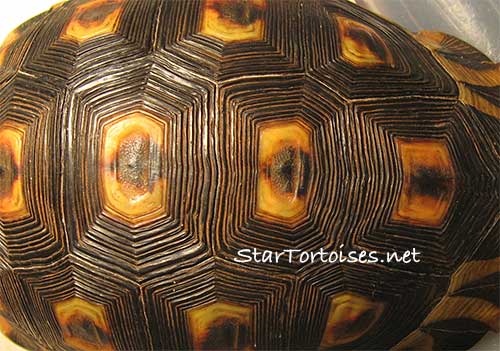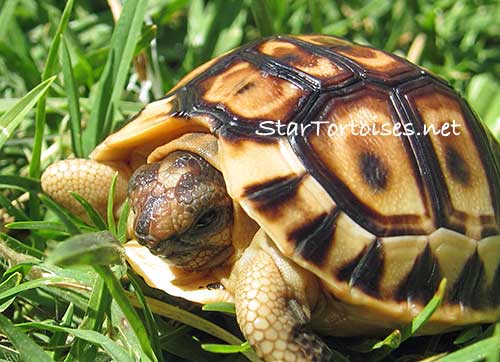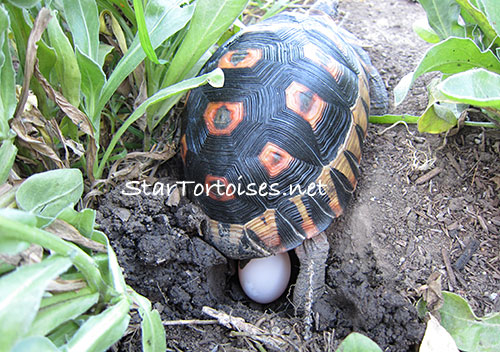


The angulate / angulated tortoise (Chersina angulata) is a beautiful tortoise native to South Africa and has a marginal presence in Namibia. Even though it is not a star patterned tortoise, it has lovely shell markings of dots and triangular stripes. So, it's a star among tortoises to me. :O)
The angulate tortoise was probably named after the dark triangles on the marginal scutes because angulata (angulatum) means angular (pointed, V-shaped).
In the past, bowsprit tortoise was the familiar name for this species. This name comes from the large, undivided gular scute (throat shield) angulate has under its head. Bow is the most forward part of a ship, and bowsprit of a sailing ship is the long pole extending out in the front of the ship.
Today, both angulate tortoise and angulated tortoise are commonly used. CITES uses the common name angulated tortoise with letter d at the end. I use the shorter word angulate because that's the name found in South African herpetological literature.
The angulate is a small to medium sized tortoise. Males can reach up to 10.5" (27 cm) and females up to 8.5" (21.5 cm). A few may grow up to 12" (30 cm). Specimens on the west coast and especially on the Dassen Island tend to grow larger than those from the eastern part of their range.
The carapace is domed and elongated with steep sides. Coloring is a mix of light brown or yellow and black, but color pattern can vary even within the same population. Some animals are light in color, almost golden brown, while others are much darker. Carapace scutes have a yellow or orange-reddish center with a dark dot in the middle.
Plastron may be light brown to pale yellow and has bright markings of yellow, orange or red. The gular scute below the head is single and undivided. Adult males have noticeable longer gulars than females.
Confusing names: The South African angulate / angulated tortoise (Chersina angulata) is NOT the same species as the Madagascar angulated tortoise aka angonoka or ploughshare tortoise (Astrochelys [Geochelone] yniphora) which is critically endangered and on the IUCN Red list.

Angulate tortoises usually have dark shells, but lighter colored individuals exist as well. Vertebral and costal scutes have a yellow or orange-reddish center with a dark dot in the middle. Marginal scutes have triangular shapes of darker and lighter colors.
The angulate tortoise lives in a variety of habitats in different climate zones with varying vegetation, from semi desert regions to high rainfall areas. Habitats include fynbos (scrub land), succulent karoo (arid with succulents), nama karoo (arid scrub land), and albany thicket (scrub land with succulents). Depending on their home area, they may endure extremely hot summers and cold to freezing winters. This tortoise is said to prefer sandy coastal regions with bushveld (sub-tropical woodland) and fynbos (type of vegetation of small trees and scrubs found only on the southern tip of South Africa).
The angulate tortoise inhabits many national parks, for example, Addo, Table Mountain, and West Coast. Dassen Island has the highest density of angulate tortoises, up to 100 tortoises per hectare. It is a small island nature reserve in the Western Cape about 34 miles (55 km) north of Cape Town and north of Robben Island. Dassen Island is free of natural predators and experiences a temperate, Mediterranean type climate.
Mediterranean climate is characterized by warm to hot, dry summers and cool, rainy winters. This climate is mainly found in California, Central Chile, the Cape Region of South Africa, the southwestern part of Australia and, of course, around the Mediterranean Sea.
Angulate tortoises are lively, quick, and agile. They have been described as shy and secretive in the wild. Captive-bred angulates tend to be less timid, and they can become quite tame and responsive to their owners.
Depending on temperature, they may remain active throughout the year. Typical activity temperature range has been observed to be between 57 °F (14 °C) and 84 °F (29 °C). On cool days, they are active in the middle of the day and on hot days mornings and afternoons. Rain and fog increase activity. It’s considered to be one of southern Africa's hardiest tortoises.
Like most tortoises, they like to hide under plants and may partially bury into sand under a bush. They are not a burrowers, but may hide in natural tunnels.

A gorgeous baby angulate tortoise. Hatching angulate tortoise eggs in captivity has proven to be very tricky.
Currently, the angulate is one of the least common tortoise species in the U.S. Very few tortoise keepers own this species and captive bred angulates are rarely available. Although, in recent years the interest of keeping and breeding this species has grown.
In the past, a sizable number of angulate tortoises were exported out of Africa. Most of them are said to have died within months due to inability to adjust to the humid conditions in parts of the U.S. and Europe. Angulate tortoises seem to do best in Mediterranean type climate areas.
According to a 2000 Turtle and Tortoise Newsletter (4:8-13), 368 angulate tortoises were imported to the U.S. between 1989 and 1997. As a comparison, 11,773 Leopard tortoises and 2,982 Sulcatas were imported during the same time period. (Note: In 2000, the U.S. Department of Agriculture halted further importation of certain land tortoises, including leopards and sulcatas, because they were harboring exotic ticks known to be vectors of heartwater disease.)
The European Studbook Foundation (ESF) managed a studbook breeding program for the angulate tortoise starting in 1999. During the 1980's and 1990's, several tortoises were imported from South Africa by ESF members and other keepers. Unfortunately, reproduction was limited and death rate was high. Due to few participants and low numbers of tortoises in the studbook, ESF discontinued this program in 2009. However, several tortoise keepers in Europe who are not listed in the studbook keep and raise this species.

Mama angulate tortoise laying her large egg. Angulate tortoises usually lay only one egg at a time, but occasionally two eggs may be deposited.
My adult angulate tortoises are actually quite laid back and easy going. They aren't very shy and don’t pull their heads in if I’m nearby. They stay relaxed even if I lift them up and carry them somewhere. My angulate babies can be either way, some are timid while others are more brave and outgoing.
The angulate tortoise is not considered threatened nationally in South Africa, but local populations may be endangered. Threats include loss of habitat due to agricultural and urban development, illegal collecting for pets and food (tortoise barbeque, skildpadbraai), wild fires, cars, dogs, and natural predators like baboons, jackals, mongoose, and birds.
In South Africa, the angulate tortoise is a protected wild animal by the Nature Conservation Ordinance 19 of 1974 (2000) and requires a special permit to keep. It is also listed in the Appendix II of CITES (01/07/1975) which regulates international trade. On the IUCN Red List it is classified as least concern (LC) with the population trend as stable and not severely fragmented.